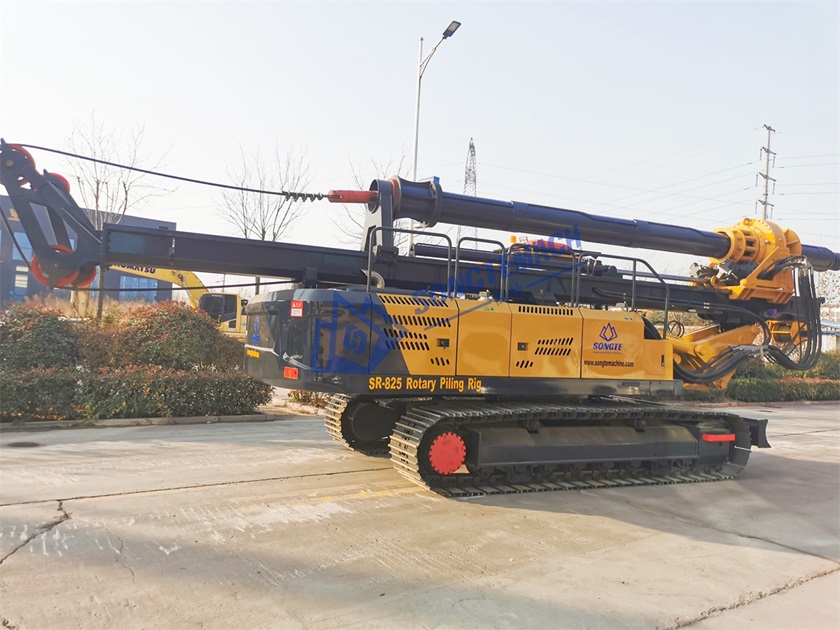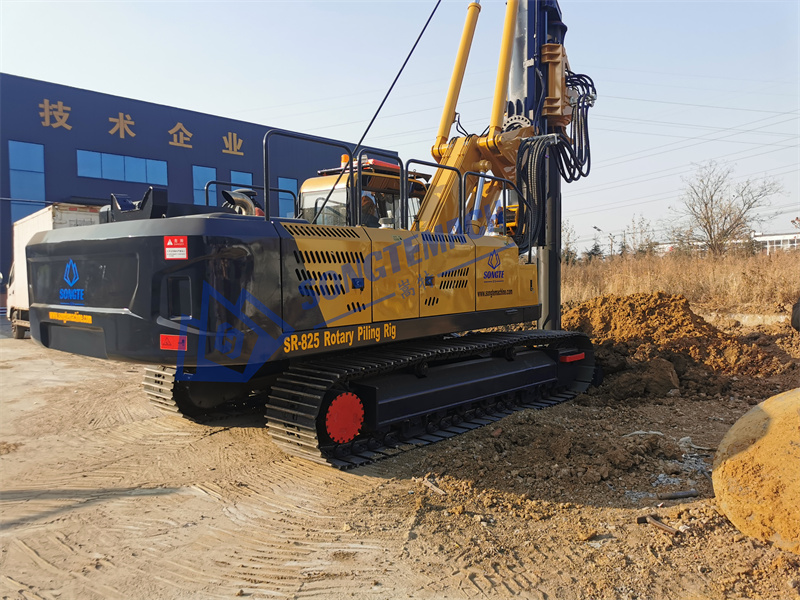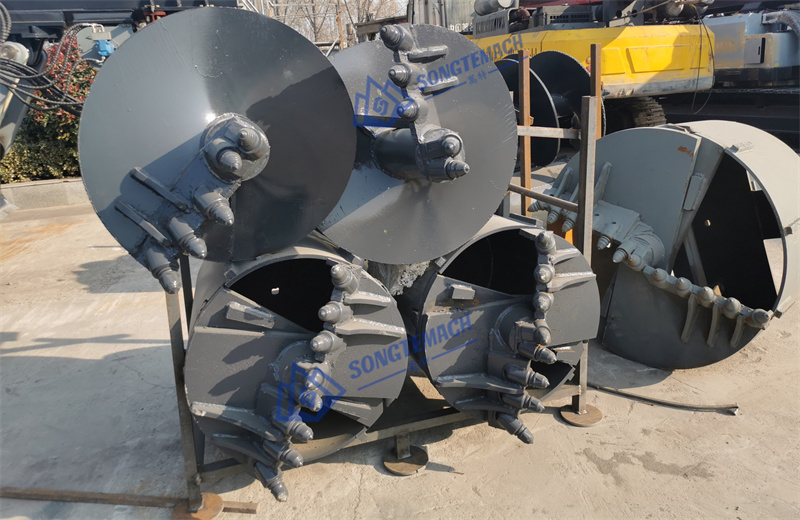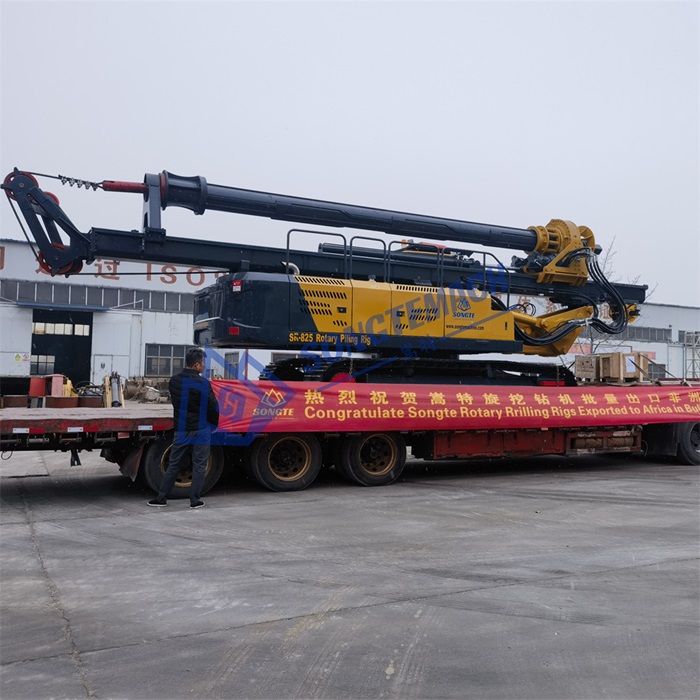Rotary Drilling Rigs: The Ultimate Solution for Pile Foundation Construction
Rotary Drilling Rigs Introduction, What Is Rotary Drilling Rig?
Rotary drilling rigs, a high-performance construction machine, is widely utilized in various foundation projects. It showcases several notable features, including high power, substantial output torque, considerable axial pressure, and strong flexibility, enabling efficient construction and multifunctional operations. This rig can adapt to diverse geological conditions, making it suitable for a wide range of large-scale projects such as building cast-in-place piles, bridge piles, power grid foundation piles, underground tunnels, subways, highways, docks, and dams.
It belongs to the category of pile drilling equipment and serves as a foundation piling rig or bored pile rig. With its hydraulic system, it can also be classified as a hydraulic pile rig. The rig can operate on a crawler basis, thus being referred to as a crawler piling rig. Available in mini and micro versions, it finds applications in specific projects. Manufacturers specialize in producing these pile rigs, including auger pile rigs. Whether it’s a standard or specific type of pile rig, the rotary drilling rig plays a vital role in the field of pile foundation machines.
SR-825 Crawler Hydraulic Rotary Piling Machine For Drilling Piles 25m

Composition of Rotary Drilling Rigs
The composition of rotary drilling rigs, which plays a vital role in pile foundation construction, mainly consists of the following components:
Drilling equipment: Includes drill bits, drill pipes, and other associated tools for performing the drilling operations.
Power system: Provides the necessary power to drive the drilling equipment.
Control system: Manages and controls the various functions and operations of the rig.
Structural framework: Supports the entire rig and ensures its stability.
Transmission system: Transfers power from the power source to the drilling equipment.
Cooling system: Keeps the rig from overheating during prolonged operations.
Lifting and hoisting equipment: Used for handling and positioning the drill pipes and other components.
Navigation and positioning system: Helps in accurate alignment and positioning of the rig.These components collectively form the rotary drilling rig, which is a crucial part of construction machinery specifically designed for pile foundation construction. The efficient operation of these rigs relies on the proper functioning and coordination of all these components.
Working Principle of Rotary Piling Machine
The working principle of rotary drilling rigs typically involves the following steps:
- Power source: A motor or engine provides the necessary power to drive the rig.
- Rotary motion: The rig rotates the drill bit, allowing it to cut through the ground.
- Feed mechanism: The drill bit is advanced into the ground to deepen the hole.
- Hydraulic system: Used for power transmission and control of various components.
- Drilling fluid: Circulated to cool the drill bit and remove cuttings from the hole.
- Depth measurement: To monitor the progress of the drilling operation.
- Stability: Ensured through a properly balanced and supported rig structure.
- Geological assessment: Used to evaluate the subsurface conditions.
- Adaptability: Can handle different soil types and geological formations.
- Precision: Able to create accurate and straight holes for subsequent construction activities.
The combination of these elements enables the rotary drilling rig to efficiently create deep holes in various substrates, providing a solid foundation for structures such as buildings, bridges, and infrastructure. The rig’s design and operation are optimized to ensure safety, productivity, and quality in the drilling process.
Characteristics and Types of Rotary Drilling Rigs
Rotary drilling rigs possess the following characteristics:
– Heavy-duty construction for handling challenging projects.
– Utilizes hydraulic power for efficient and precise operation.
– Suitable for geotechnical drilling in various soil conditions.
– Essential construction equipment for foundation engineering.
– Used in infrastructure development, including buildings and bridges.
– Employed in deep foundation construction for stability.
The types of rotary drilling rigs include:
– Heavy-duty drilling rig for large-scale projects.
– Hydraulic drilling rig for power and control.
– Auger drilling rig for efficient hole creation.
– Piling rig for installing piles in the ground.
– Hydraulic piling rig for enhanced performance.
– High-power drilling rig for demanding applications.
– High-power piling rig for increased capacity.
– Auger piling rig for specific pile installation needs.
These rigs are essential pieces of construction site equipment, providing the necessary tools for foundation construction and infrastructure development. Their different types allow for customization based on project requirements and soil conditions, ensuring efficient and reliable performance in various drilling rig applications.
Applications of Rotary Pile Drilling Rigs
(Rotary Drilling Rig Construction Case)

Rotary drilling rigs find diverse applications in various facets of foundation construction, offering efficient solutions for a wide range of projects. Here are some key applications where rotary drilling rigs excel:
Pile Foundation Drilling Equipment: Rotary drilling rigs play a pivotal role in drilling boreholes for pile foundations, ensuring the stability and load-bearing capacity of structures. These rigs are adept at drilling deep into the ground to install piles securely, providing a solid foundation for buildings, bridges, and other structures.
Construction Drilling Rig: In construction projects requiring drilling operations, rotary drilling rigs are indispensable. Whether it’s creating foundation piles, installing utility poles, or excavating for underground structures, these rigs deliver reliable performance and precision.
Hydraulic Drilling Rig for Piles: Hydraulic rotary drilling rigs are specifically designed for pile foundation construction, offering high-power hydraulic systems that drive drilling operations with efficiency and accuracy. These rigs are ideal for installing piles in various soil conditions, from soft clay to hard rock.
Geotechnical Drilling Equipment: Rotary drilling rigs are widely used in geotechnical exploration and soil testing. They facilitate the collection of soil samples and conduct geotechnical surveys to assess ground conditions and determine the suitability of sites for construction projects.
Foundation Construction Machinery: As key components of foundation construction machinery, rotary drilling rigs contribute to the efficient and timely completion of projects. Their versatility, power, and precision make them essential tools for constructing stable and durable foundations.
Heavy-Duty Drilling Rig for Foundations: When it comes to building foundations for large structures such as skyscrapers, bridges, and industrial facilities, rotary drilling rigs are the go-to choice. Their heavy-duty construction and high-power capabilities enable them to tackle the demanding requirements of foundation construction with ease.
Pile Foundation Drilling Solutions: Rotary drilling rigs offer comprehensive solutions for pile foundation drilling, addressing the diverse needs of construction projects. From standard drilled shafts to specialized pile types like auger piles and micro piles, these rigs provide versatile and efficient drilling solutions tailored to specific project requirements.
The applications of rotary pile drilling rigs are diverse and include the following:
- Building construction: For creating stable foundations for commercial and residential buildings.
- Bridge construction: To ensure solid support for bridges.
- Infrastructure projects: Such as roads, airports, and seaports.
- Industrial facilities: Plants, warehouses, and power stations.
- Coastal structures: Sea walls, breakwaters, and jetties.
- Mining operations: To install support structures.
- Renewable energy projects: Solar and wind farms.
- Retaining walls: For stability in construction sites.
- Underground parking lots: For solid foundation support.
- Land reclamation projects: To build on reclaimed land.
- Railway tracks: For stable foundations.
- Telecommunication towers: For secure base installation.
Construction Technology and Procedures of Rotary Pile Drill Machine
The construction technology and procedures of rotary piling rig involve the following steps:
- Site preparation: Including leveling the ground and setting up the rig.
- Rig setup: Placing the deep foundation drilling equipment at the designated location.
- Drill bit selection: Choosing the appropriate drill bit for the soil conditions.
- Auger drilling: Using the auger drilling machine to create the initial hole.
- Soil removal: Removing the excavated soil through the auger or other means.
- Depth control: Monitoring the depth of drilling to ensure accuracy.
- Concrete placement: Pouring the concrete into the hole for the pile formation.
- Pile reinforcement: Installing reinforcement if required.
- Quality control: Checking the integrity and strength of the constructed pile.
These steps are essential in the construction process using rotary piling rigs, which are commonly used in civil engineering drilling rigs for various foundation works. The auger drilling machine plays a crucial role in efficient and precise hole creation.
Classification of common rotary drilling rig drill bits

Common rotary drilling bits include spiral drill bits, rotary buckets, barrel core drill bits, bottom expansion drill bits, impact drill bits, grab cone drill bits and hydraulic grab buckets. The following is a brief introduction by category.
1. Spiral drill bit
(1) Conical: double-headed double spiral, suitable for hard bedrock. Double-headed single snail, suitable for weathered bedrock, pebbles, frozen soil, etc. The above drill bits are equipped with various picks, and many types of drill bits can be derived through changes in tooth shape, pitch, and helix angle.
(2) Straight spiral drill bit:
a. Bucket tooth straight screw: double-headed double screw, suitable for sandy soil and small-diameter gravel layer with poor cementation; double-headed single screw, suitable for sandy soil and soil layer; single-headed single screw, suitable for large-diameter gravel layer with poor cementation Pebbles, clayey soil and hard clay.
b. Straight pick screws: There are double screws, triple screws and quadruple screws, suitable for hard bedrock or pebbles.
2. Sand bucket
According to the installed teeth, it can be divided into pick pick sand fishing bucket and bucket tooth sand fishing bucket; according to the number of bottom plates, it can be divided into double bottom sand fishing bucket and single bottom sand fishing bucket; according to the number of door openings, it can be divided into double door bucket and single door bucket. ;According to the taper of the cylinder, it can be divided into conical sand fishing bucket and straight sand fishing bucket. By combining the above structural forms with each other, plus the changes of whether it has ventilation holes and the door-opening mechanism, dozens of rotary drilling buckets can be combined. Generally speaking, the double-bottomed sand scoop is suitable for a wider range of strata, the single-bottomed one is only suitable for sticky soil layers, the double-door drill bucket is suitable for a wider range of strata, and the single-door drill bucket is only used for large-diameter pebbles and Hard mastic.
3. Barrel drill
There are two common types at present: pick barrel drill (suitable for medium-hard bedrock and pebbles), and cone barrel drill (suitable for hard bedrock and large boulders). Among the two major types of barrel drill bits, there are those with and without coring devices, which mainly depends on the difficulty of coring. Because roller cone drills are mainly used for hard rock drilling, and the drilled annular area is large, if conditions permit, reverse circulation drilling can be installed on the drill bit to improve drilling efficiency.
4. Bottom expansion drill bit
On the basis that the pile diameter does not increase and the pile depth does not increase, in order to improve the bearing capacity of a single pile, the design department often achieves it by expanding the bottom pile. The bottom expansion can be constructed without any modifications when using a rotary drilling rig. You only need to use an expanded pile. Just use the bottom drill bit. The most commonly used base expansion drill bits are mechanical. This type of drill bit is relatively simple to use and maintain. There are top-opening and bottom-opening types. The opening mechanism is generally a four-link type. It is used for soil layers, strong winds, and weathering. Strata and even hard bedrock. Since rotary drilling is non-circulatory drilling, just use a cleaning bucket to clean the slag after the bottom expansion is completed.
5. Impact drill bit, punch taper drill bit
When drilling large-diameter pebbles, large boulders and hard bedrock, it is particularly effective to use impact drill bits and grab cone drill bits in conjunction with rotary drilling. This type of drill bit is used for hanging by the auxiliary hook of the rotary excavator because it requires Impact effect, so the auxiliary hook is required to have the function of free rope release to achieve better results.
6. Hydraulic grab
At present, there are more and more construction projects of diaphragm walls and anti-seepage walls. If the rotary drilling rig is slightly modified, it can be operated. The opening and closing of the hydraulic grab is driven by hydraulic pressure. There is only one cylinder on the hydraulic grab, so only Two oil pipes are needed to enter and exit, and one control valve is enough.
Advantages of Rotary Pile Drill Rig in Pile Foundation Construction
In the world of construction, the rotary pile drilling rig stands out as a powerhouse of efficiency and precision. Let’s explore the numerous advantages it offers and how it has become an essential component in the field of foundation construction.
One of the key advantages of the rotary pile drilling rig is its high efficiency. Capable of quickly drilling through various soil types, it significantly reduces the time and effort required for piling works. This makes it an ideal choice for large-scale construction projects where time is of the essence.
Another advantage is the precise hole placement it provides. With advanced technology and precise controls, the rig ensures that each pile is accurately positioned, resulting in a solid and stable foundation.
The versatility of the rotary pile drilling rig is also notable. It can adapt to different soil conditions and project requirements, making it a highly flexible solution for a wide range of construction needs.
In terms of cost-effectiveness, this rig offers a cost-efficient alternative compared to other foundation construction methods. Its efficiency and minimal downtime contribute to overall project savings.
Reliability is another aspect where the rotary pile drilling rig shines. Built to withstand the rigors of construction, it requires less maintenance and offers consistent performance.
When it comes to safety, this rig is designed with numerous safety features to protect the operators and ensure a safe working environment.
In conclusion, the rotary pile drilling rig offers numerous advantages that make it a valuable asset in the construction of solid and reliable foundations. Its association with popular keywords further emphasizes its significance in the field.
How to Choose the Right Rotary Drilling Rig / Piling Machine
In the construction industry, choosing the right rotary drilling rig or piling machine is crucial for the success of a project. With numerous options available in the market, it can be overwhelming to make the right choice. Here are some factors to consider when selecting the perfect rotary drilling rig / piling machine for your needs.
First and foremost, determine your project requirements. Consider the type of soil, depth of drilling, and specific foundation requirements. This will help you narrow down the suitable rig models.
Next, research different brands and their reputations. Look for reputable rotary drilling rig brands known for quality and reliability. Check customer reviews and references to gain insights into their performance.
Consider the rotary drilling rig specifications, such as power output, drilling speed, and maximum depth capacity. Ensure the rig can handle the demands of your project.
Pricing is an important factor. Compare the prices of different rigs, including hydraulic piling rig prices, to ensure you get the best value for your budget.
Look for reliable pile driving rig manufacturers and piling rig suppliers who can offer after-sales support and service. A good supplier will provide maintenance, spare parts, and technical expertise.
Evaluate the available pile driving equipment for sale and foundation piling machine for sale. Consider the features and capabilities of each model to find the one that best suits your project.
Check the pile foundation drilling rig models and their compatibility with your existing construction equipment and workflow.
Understand the different rotary piling rig prices and their associated features. Higher-priced rigs may offer additional capabilities or better performance.
Finally, consider the pile driving rig specifications, such as size, weight, and power requirements, to ensure it can be easily transported and operated on your site.
By considering these factors, you can make an informed decision and choose the right rotary drilling rig / piling machine that meets your project requirements and budget. Remember to consult with experienced suppliers and industry experts for further guidance.”
Rotary Drilling Rigs Exported to Africa in Bulk

How Does the Rotary Drilling Rig Work
The rotary drilling rig is a powerful piece of equipment used in various construction and drilling projects. Understanding how it works is essential for efficient and successful operations. Here’s an overview of the functioning of a rotary drilling rig:
The drill bit, a crucial component, is rotated and driven into the ground to create the hole. The rotation allows for efficient penetration through different types of soil and rock.
A power source, usually an engine or motor, provides the necessary energy to rotate the drill bit. This ensures smooth and continuous operation of the rig.
The rig also incorporates a feed system that pushes the drill bit downward, adding pressure for deeper holes.
A cooling system is in place to prevent overheating of the drill bit and other components. This helps extend the lifespan of the equipment.
The drill rig is mounted on a stable platform to ensure proper alignment and stability during operation.
To handle the drilled material, a mud or fluid system is used. It helps to remove the cuttings and keeps the hole clear.
Operators control the rig using a panel or console, allowing them to monitor and adjust various parameters.
The choice of drill bit depends on the specific project requirements and ground conditions.
In conclusion, the rotary drilling rig works by combining power, rotation, and feed systems to drill precise holes in different substrates. Its efficient operation relies on proper component selection, operator expertise, and adherence to safety standards.
Rotary Pling Rig Maintenance And Precautions
Rotary drilling rig maintenance and precautions are crucial to ensure the normal operation and service life of the equipment. The following are some important points:
1. Regular maintenance:
– Perform routine inspections according to the manufacturer’s recommendations.
– Check lubrication systems and replace lubricants regularly.
– Inspect and replace worn or damaged parts in a timely manner.
2. Cleaning and dust removal:
– Keep the rig clean to prevent dust and debris from entering the key components.
– Clean the cooling system to ensure proper heat dissipation.
3. Engine maintenance:
– Follow the engine manufacturer’s maintenance schedule.
– Check and replace air filters, oil, and fuel filters regularly.
4. Hydraulic system:
– Monitor the hydraulic fluid level and quality.
– Check for leaks and address them promptly.
5. Electrical system:
– Inspect electrical connections and replace damaged wires or components.
6. Precautions:
– Follow operating procedures and safety guidelines strictly.
– Train operators to operate the rig correctly.
– Use appropriate tools and spare parts for maintenance.
– Avoid overloading the rig beyond its rated capacity.
– Pay attention to weather conditions and take appropriate measures.
– Keep detailed maintenance records for future reference.
By following these maintenance and precaution measures, the performance and reliability of the rotary drilling rig can be ensured, reducing the risk of breakdowns and extending its service life.
 songtemachine
songtemachine
